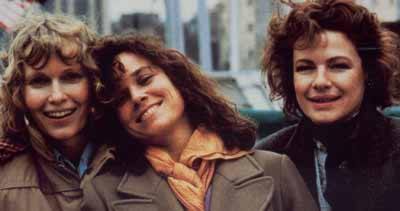Hannah and Her Sisters(1986)

In 1986, Woody Allen returned, older and perhaps a bit wiser, to territory he had previously visited somewhat in both Annie Hall and Manhattan. The result was the Oscar nominated film Hannah and Her Sisters, a movie inspired by a various range of sources - from the plays of Henrik Ibsen to some of the later character studies of Ingmar Bergman (most notably its echoes of Cries and Whispers with its familial, sisterly themes). Yet, despite its obvious influences, the film stands alone as a true masterpiece from one of cinema's most creative and prolific auteurs.
The plot of Hannah and Her Sisters reads deceptively simple. At its heart it is the story of three sisters, their relationships with each other and with the world around them, over the course of a single year. Mia Farrow plays the title role of Hannah, with Dianne Wiest and Barbara Hershey playing the equally important "sister" roles. Each of the three sisters is distinctly different. We have Farrow's Hannah, one of the more complex within the family. She is married to Michael Caine (perfectly cast here), and is constructed as the most competent of three sisters, and thus the nurturer of the three. Wiest plays a neurotic, struggling actress (somewhat similar in style to Judy Davis in the more recent Allen films). The third sister is Barbara Hershey's character, a woman who has lived for years with an "important" artist, several years her elder. The artist is played by Max von Sydow (yet another Bergman connection in Allen's work) and, as an artist, he hates the world, forcing Hershey's character to serve as both his muse and his only really contact with the outside world.
The only other major character is Mickey, played by Allen himself in typical neurotic glory. Mickey is a self-confessed hypochondriac, and fears death on a daily basis. The Mickey character is basically an outsider throughout the story, the only real connection to the "main" story being that he was once married to Hannah (Farrow). However, some of the funniest scenes in the entire film come from Mickey, as we watch him struggle with his neurosis and try desperately to find meaning - and a religion to be a part of - before his life his over. Some have said that Mickey provides the film with comic relief, but I believe that belies both the seriousness of his character's struggle, and the rather humorous scenes to be found in the "real" story not involving Mickey.
Allen lays out the basic relationships and connections of the main characters in the opening scenes. From there, however, everything becomes quite complicated. Hannah's husband Eliot (Michael Caine) confesses in voice over that he has actually always been attracted to Hershey's character. Eventually he goes so far as to confess his love to her, somewhat awkwardly, and quite quickly the complexities of sisterhood, love, and adultry all come to the forefront. Von Sydow is crushed of course, and we see him as he truly is, not the proud, distinguished artist that he pertains to be, but rather a heavily dependent man who uses intimidation to try and control the one thing in life he can't seem to live without. At the same time, we watch Caine's character as he struggles with issues of guilt - lying next to Hannah and realizing (with much horror) the pain he might cause her should she ever find out about his secret crush on her sister.
Allen, as a director, handles these relationships and their complications in a very mature fashion, perhaps foreshadowing 1989's even more serious Crimes and Misdemeanors. Both films deal with moral and ethical issues, managing to mix comedy and tragedy in a distinctive synergy that no other director has really been able to achieve. This impressive synthesis of style makes Hannah and her Sisters the great film that it undoubtedly is, something that appeals to audiences across the board and to this day remains one of Allen's most popular films.
Of course, whenever one of his films is received as well as Hannah was, Allen is quick to discredit it. He has mentioned in several interviews that he is not a fan of the ending in the film, and indeed, the rather happy conclusion is far less ambiguous than the typical Allen ending. Still, it hardly detracts from the film. The novel like approach and structure of the film (each new section begins with a white title on a black screen), the use of beautiful classical music throughout, the powerful performances of Allen, Farrow, Hershey, Wiest, Caine, and Von Sydow, combined with a brilliant artistic vision allow this film to move far beyond a character study and into a truly mesmerizing two hours of cinematic pleasure.

Release Date: February 7, 1986
Domestic Total Gross: $41,069,615
Distributor: Orion

Links
"somewhere i have never travelled" (ee cummings poem used in the film)
Roger Ebert's four-star review
Hannah and Her Sisters fan page